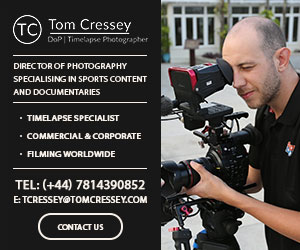Broadcast News
29/06/2012
Antenna Setup Tips For Wireless Receivers

Pyers Easton, Managing Director of Raycom Ltd shares his expert knowledge
I am frequently asked about the best antenna setups for wireless receivers to maximise range, whilst remaining as practical as possible to implement, so here are some tips:
If you are using a receiver (RX) with whip antennas on top then they are on an imperfect ground-plane (the RX body), and with other wiring around it will cause a net loss when compared to a dipole reference antenna in free space, let's assume maybe 3dB loss, maybe considerably more if RX is buried in a bag.
Now let's take a 'sharkfin' antenna, say the Lectrosonics ALP500, this has a stated gain of 4dBd (4dB relative to a dipole), but you need to factor in other losses, cable loss, assuming RG58 (typical cable for this application) is about 0.5dB/m at 700MHz, also, if you are feeding two RX from one antenna (one half of the diversity pair) then you will need a splitter, a two way splitter has a theoretical loss of 3dB (0.5 x power), but in the real world has a loss of 3.5 to 4dB. So see below for gain calculation:
• Antenna gain: 4dB
• Feeder loss assuming 3.5m cable (including 0.5m jumper from splitter to RX): -2dB
• Splitter loss: -3.5dB
• Net loss: 1.5dB
You can see from the above that you are losing 1.5dB relative to a dipole assuming no other losses, but you are 1.5dB better than the first case of 3dB loss, PLUS you would have more gain from having the antennas mounted higher up, so you will see a good benefit.
Active (amplified) systems can be very useful, but only if used properly, there are many disastrous pitfalls that can occur if not. Assuming you have an amplified antenna such as the Lectro ALP650 which you can jumper for 5dB or 8 dB gain, you could offset the losses in both the feeder and the splitter, getting you back to the nominal 4dB gain of the antenna itself. This is a net 6dB gain relative to the first case of whip antennas on RX, providing a theoretical doubling of range.
A couple of important points relating to active systems:
1: NEVER use more gain than you need to make up for the feeder and other losses between the antenna output and RX input terminals. Using more gain will not improve range, it will actually work against the RX which will be designed to have a specific internal gain structure to provide the best possible sensitivity and intermodulation performance, overloading the RX front end will compromise the intermodulation performance of the RX, reduce the amount of usable channels, and make it more susceptible to overload (blocking) by unwanted signals.
2: The weakest link effect - Always use a good quality amplifier with a high dynamic range in active systems, or the performance of the whole system will suffer. As an RF designer one of my pet hates is designing a receiver that is as good as you can only to have someone stick a cheap amplifier in front of it, thus rendering a £2000 RX no better than a £10 FM radio! The bottom line is that the RF performance of the whole system is only as good as the weakest link in the chain.
Also remember that active sharkfin antennas are wideband, so, unlike a filtered input of the RX are more susceptible to out of band signals, for example a mobile phone going off in your pocket next to the antenna whilst receiving a distant wireless mic. signal is likely to cause problems.
Personally I would always use a passive system where I can unless I really need maximum range, as the design performance of the RX is preserved and uncertainties are minimised, though once you go above 2 way splitters the splitter losses start racking up rendering active systems more attractive.
One last point about choice of antenna with gain: there are two main choices, 'Yagi' or 'Log Periodic' (sharkfin), Yagis tend to have more gain, but are more directional and have lots of 'ripple' (gain nulls, sometimes very deep) in their gain pattern so are best suited to fixed point to point links, log periodics have a good front to back ratio and a very smooth pattern, so if talent is moving around in front of the antenna they are much less likely to enter a deep null and drop out.
• Pyers Easton is Managing Director of Raycom Ltd and has been involved in RF and audio design for over 30 years.
I am frequently asked about the best antenna setups for wireless receivers to maximise range, whilst remaining as practical as possible to implement, so here are some tips:
If you are using a receiver (RX) with whip antennas on top then they are on an imperfect ground-plane (the RX body), and with other wiring around it will cause a net loss when compared to a dipole reference antenna in free space, let's assume maybe 3dB loss, maybe considerably more if RX is buried in a bag.
Now let's take a 'sharkfin' antenna, say the Lectrosonics ALP500, this has a stated gain of 4dBd (4dB relative to a dipole), but you need to factor in other losses, cable loss, assuming RG58 (typical cable for this application) is about 0.5dB/m at 700MHz, also, if you are feeding two RX from one antenna (one half of the diversity pair) then you will need a splitter, a two way splitter has a theoretical loss of 3dB (0.5 x power), but in the real world has a loss of 3.5 to 4dB. So see below for gain calculation:
• Antenna gain: 4dB
• Feeder loss assuming 3.5m cable (including 0.5m jumper from splitter to RX): -2dB
• Splitter loss: -3.5dB
• Net loss: 1.5dB
You can see from the above that you are losing 1.5dB relative to a dipole assuming no other losses, but you are 1.5dB better than the first case of 3dB loss, PLUS you would have more gain from having the antennas mounted higher up, so you will see a good benefit.
Active (amplified) systems can be very useful, but only if used properly, there are many disastrous pitfalls that can occur if not. Assuming you have an amplified antenna such as the Lectro ALP650 which you can jumper for 5dB or 8 dB gain, you could offset the losses in both the feeder and the splitter, getting you back to the nominal 4dB gain of the antenna itself. This is a net 6dB gain relative to the first case of whip antennas on RX, providing a theoretical doubling of range.
A couple of important points relating to active systems:
1: NEVER use more gain than you need to make up for the feeder and other losses between the antenna output and RX input terminals. Using more gain will not improve range, it will actually work against the RX which will be designed to have a specific internal gain structure to provide the best possible sensitivity and intermodulation performance, overloading the RX front end will compromise the intermodulation performance of the RX, reduce the amount of usable channels, and make it more susceptible to overload (blocking) by unwanted signals.
2: The weakest link effect - Always use a good quality amplifier with a high dynamic range in active systems, or the performance of the whole system will suffer. As an RF designer one of my pet hates is designing a receiver that is as good as you can only to have someone stick a cheap amplifier in front of it, thus rendering a £2000 RX no better than a £10 FM radio! The bottom line is that the RF performance of the whole system is only as good as the weakest link in the chain.
Also remember that active sharkfin antennas are wideband, so, unlike a filtered input of the RX are more susceptible to out of band signals, for example a mobile phone going off in your pocket next to the antenna whilst receiving a distant wireless mic. signal is likely to cause problems.
Personally I would always use a passive system where I can unless I really need maximum range, as the design performance of the RX is preserved and uncertainties are minimised, though once you go above 2 way splitters the splitter losses start racking up rendering active systems more attractive.
One last point about choice of antenna with gain: there are two main choices, 'Yagi' or 'Log Periodic' (sharkfin), Yagis tend to have more gain, but are more directional and have lots of 'ripple' (gain nulls, sometimes very deep) in their gain pattern so are best suited to fixed point to point links, log periodics have a good front to back ratio and a very smooth pattern, so if talent is moving around in front of the antenna they are much less likely to enter a deep null and drop out.
• Pyers Easton is Managing Director of Raycom Ltd and has been involved in RF and audio design for over 30 years.
Top Related Stories
Click here for the latest broadcast news stories.
29/11/2022
WUCW-DT Now On Air With New Dielectric UHF Antenna
Dielectric has announced that WUCW-DT, a CW affiliate serving the Minneapolis-St. Paul market, is now on the air with a new Dielectric UHF antenna tha
WUCW-DT Now On Air With New Dielectric UHF Antenna
Dielectric has announced that WUCW-DT, a CW affiliate serving the Minneapolis-St. Paul market, is now on the air with a new Dielectric UHF antenna tha
12/12/2014
HARMAN'S AKG Announces APS4 Antenna Power Splitter
HARMAN's AKG has announced the new APS4 antenna power splitter, which can be operated in an extended frequency range of 470 to 952 MHz and is availabl
HARMAN'S AKG Announces APS4 Antenna Power Splitter
HARMAN's AKG has announced the new APS4 antenna power splitter, which can be operated in an extended frequency range of 470 to 952 MHz and is availabl
24/05/2016
Dielectric Antenna Systems Planning 7.0 Released As Free Web-Based Service
Dielectric has released version 7.0 of its Dielectric Antenna Systems Planning (DASP) software for TV and FM systems. As the first web-based version o
Dielectric Antenna Systems Planning 7.0 Released As Free Web-Based Service
Dielectric has released version 7.0 of its Dielectric Antenna Systems Planning (DASP) software for TV and FM systems. As the first web-based version o
23/06/2008
Jampro To Provide Antenna Systems To India's CTI
Jampro Antennas of Sacramento, a leading supplier of antennas, combiners & filters and RF components, has announced that the company has been awarded
Jampro To Provide Antenna Systems To India's CTI
Jampro Antennas of Sacramento, a leading supplier of antennas, combiners & filters and RF components, has announced that the company has been awarded
21/07/2022
Sound Devices Ships A20-RX
Sound Devices is shipping the A20-RX: a two channel, true diversity receiver with industry-exclusive SpectraBand technology. SpectraBand gives the A20
Sound Devices Ships A20-RX
Sound Devices is shipping the A20-RX: a two channel, true diversity receiver with industry-exclusive SpectraBand technology. SpectraBand gives the A20
28/08/2025
Hiltron To Debut Latest-Generation Motorised Antenna Mount At IBC
Hiltron Communications' latest-generation HMAM-XY motorised antenna mount will form the centrepiece of the company's exhibit on stand 1.A37 at the 12-
Hiltron To Debut Latest-Generation Motorised Antenna Mount At IBC
Hiltron Communications' latest-generation HMAM-XY motorised antenna mount will form the centrepiece of the company's exhibit on stand 1.A37 at the 12-
20/02/2025
Antenna Group Selects Ateme's Transcoding And Packaging Solution
Antenna Group has selected Ateme's cutting-edge transcoding and packaging solution to power ANT1+, its OTT service in Greece, hosted on Google Cloud.
Antenna Group Selects Ateme's Transcoding And Packaging Solution
Antenna Group has selected Ateme's cutting-edge transcoding and packaging solution to power ANT1+, its OTT service in Greece, hosted on Google Cloud.
14/11/2024
Dielectric And BAI Finalise Installation Of A Broadband FM Antenna System
Dielectric and BAI Communications (BAI) have finalised the installation of a broadband FM antenna system for the Australian Broadcasting Corporation (
Dielectric And BAI Finalise Installation Of A Broadband FM Antenna System
Dielectric and BAI Communications (BAI) have finalised the installation of a broadband FM antenna system for the Australian Broadcasting Corporation (
19/09/2024
Antennaware And Raycom Launch Innovative New Antenna
Launched at IBC 2024, the Sub-GHz BodyWave™ antenna promises notable increases in wireless range and reliability of signal in a form factor designed s
Antennaware And Raycom Launch Innovative New Antenna
Launched at IBC 2024, the Sub-GHz BodyWave™ antenna promises notable increases in wireless range and reliability of signal in a form factor designed s
25/06/2024
Hiltron Experiences Growing Demand For Ground Antenna Refurbishment
Hiltron Communications has announced increasing demand for its refurbishment capabilities across the entire satellite communications sector, from high
Hiltron Experiences Growing Demand For Ground Antenna Refurbishment
Hiltron Communications has announced increasing demand for its refurbishment capabilities across the entire satellite communications sector, from high
12/04/2024
DNAV To Create A Microphone-To-Antenna Experience
DNAV is to create a microphone-to-antenna experience featuring its broadcast radio technology partners at NAB Show 2024, beginning Sunday at the Las V
DNAV To Create A Microphone-To-Antenna Experience
DNAV is to create a microphone-to-antenna experience featuring its broadcast radio technology partners at NAB Show 2024, beginning Sunday at the Las V
03/04/2024
Wisycom To Display Wireless And Distributed Antenna System Solutions
Wisycom is to showcase several of its latest wireless and distributed antenna system solutions at NAB 2024 (Booth C7507). Included among these is the
Wisycom To Display Wireless And Distributed Antenna System Solutions
Wisycom is to showcase several of its latest wireless and distributed antenna system solutions at NAB 2024 (Booth C7507). Included among these is the
21/03/2024
Dielectric To Unveil New FM-Ring Style Antenna
NAB Show 2024 brings a new entry to Dielectric's revered DCR range of FM antennas, extending the benefits of its lightweight, ring-style designs acros
Dielectric To Unveil New FM-Ring Style Antenna
NAB Show 2024 brings a new entry to Dielectric's revered DCR range of FM antennas, extending the benefits of its lightweight, ring-style designs acros
13/04/2023
Dielectric To Unveil Top-Mounted, Free-Standing UHF Broadband Pylon Antenna
Dielectric is to introduce its first top-mounted, free-standing UHF broadband pylon antenna at NAB Show 2023, building on more than 15 years of field-
Dielectric To Unveil Top-Mounted, Free-Standing UHF Broadband Pylon Antenna
Dielectric is to introduce its first top-mounted, free-standing UHF broadband pylon antenna at NAB Show 2023, building on more than 15 years of field-
06/04/2023
Challenger Communications Announces New 2023 NAB Show Antenna Package
Challenger Communications LLC has announced a new 2023 NAB Show antenna package designed to help earth station antenna operators ensure compliance wit
Challenger Communications Announces New 2023 NAB Show Antenna Package
Challenger Communications LLC has announced a new 2023 NAB Show antenna package designed to help earth station antenna operators ensure compliance wit















